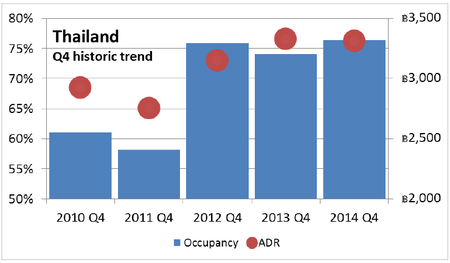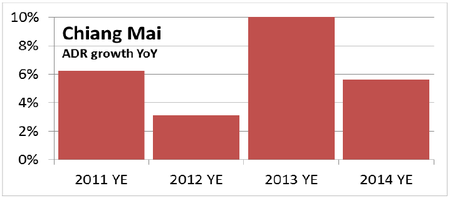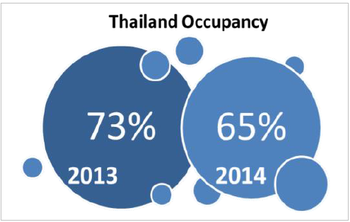The WPJ
THE WORLD PROPERTY JOURNALReal Estate Facts Not Fiction
Vacation Real Estate News

Thailand Hotel Market Shows Resilience in 2014
Vacation News » Bangkok Edition | By Miho Favela | January 27, 2015 8:55 AM ET
According to STR Global, a recovery that began to emerge late in the third quarter of 2014 couldn't help Thailand's hotel industry overcome a dismal first half of the year as the industry reported a year-over-year occupancy decline of 11.3 percent.
 The country's occupancy drop was primarily driven by Bangkok's hotels, which had a year-over-year 16.2-percent decline. During more than six months of the year, occupancy in the city was down more than 20 percent year over year.
The country's occupancy drop was primarily driven by Bangkok's hotels, which had a year-over-year 16.2-percent decline. During more than six months of the year, occupancy in the city was down more than 20 percent year over year.Phuket's occupancy dropped 5.7 percent year over year, which led to levels just slightly above those of 2011--this mainly driven by low-season (May through June) decline beyond normality--and less peak season effects. Koh Samui held up reasonably well, with a slight decrease in occupancy of 1.6 percent over 2013, and the only negative effect year over year was during low season.
The Q4 resurge
The recovery that began late in the third quarter blossomed in Q4 as numbers dramatically turned around for Bangkok. After the dismal start to the year, revenue per available room increased by 2.5 percent year over year in the last quarter.
 Occupancy in December for Bangkok was one of the highest recorded by STR Global since 2000. It was the best Q4 for Bangkok occupancy since 2006.
Occupancy in December for Bangkok was one of the highest recorded by STR Global since 2000. It was the best Q4 for Bangkok occupancy since 2006.The story is similar for Thailand as a whole. RevPAR was the second best Q4 for the last decade. It would thus suggest that six to nine months is the new recovery time norm for Bangkok, according to Jesper Palmqvist, STR Global's area director-Asia Pacific.
Rates held in pockets
In local currency terms, average daily rate for Thailand as a whole in 2014 was up 2.6 percent year over year, with Bangkok once again proving that it is able to sustain rates throughout market turmoil. While there were hotels that lost significant rates, the fact that ADR ended flat year over year speaks volumes to the amount of hotels firmly holding their ground.
 "It was slightly different for resort markets. Though Koh Samui's rates for peak season aren't at historic record levels, the market's hotels have continuously lifted rates during lower demand seasons, with less of the drastic negative rate movements seen in the past", Palmqvist said. This is particularly interesting since Koh Samui has more seasonal variety than a destination such as Phuket.
"It was slightly different for resort markets. Though Koh Samui's rates for peak season aren't at historic record levels, the market's hotels have continuously lifted rates during lower demand seasons, with less of the drastic negative rate movements seen in the past", Palmqvist said. This is particularly interesting since Koh Samui has more seasonal variety than a destination such as Phuket. Phuket has consistently raised peak season rates (December through January) since the reboot in 2010 and after the low season floor was raised back in 2012; it has been sustained each year.
RevPAR: Resorts fared better
"One impressive market to mention was Chiang Mai, though occupancy decreased 4.2 percent on a year-over-year basis. The market's hotels had positive RevPAR growth driven by continued positive ADR movement. This is particularly qualitative when considering that Chiang Mai has grown rate by solid numbers for the past few years", according to Palmqvist.
Hua Hin was also able to hold rates reasonably well, but Pattaya suffered more due to a 10-percent decline in occupancy year over year.
The supply story
Supply growth has continued to slow and seems to have aided performance during the economic downturn in 2014, specifically during the second half of the year. STR Global hasn't seen such low supply growth in Thailand as a whole for 10 years, and Bangkok was the main contributing market to that trend.
Sign Up Free | The WPJ Weekly Newsletter
Relevant real estate news.
Actionable market intelligence.
Right to your inbox every week.
Real Estate Listings Showcase
Related News Stories
Vacation Real Estate Headlines
- Record 119 Million Americans Traveling Over the Christmas Holidays
- 80 Million Americans to Hit the Road, Skies and Seas for 2024 Thanksgiving Holiday
- Asia Pacific Hotel Investment to Exceed $12 Billion in 2024
- Asia Pacific Hotel Investment Tops $12 Billion in 2024
- Seattle, Orlando and New York Top Labor Day Destinations in 2024
- Record 71 Million Americans Traveling Over July Fourth Week
- Major Hotel Operators Expanding Rapidly Across Asia Pacific in 2024
- 44 Million Traveling Memorial Day Weekend, Second Most in History
- South Korea is Asia Pacific's Top Performing Hotel Market
- Florida Dominates Top 10 U.S. Cities List to Invest in Short Term Rentals
- Investment in South Korea Hotels Dipped in 2023
- European Hotel Values Still Below Pre-Covid Prices
- Over 115 Million Americans Traveling Over Christmas Holidays
- 55.4 Million Americans on the Move Thanksgiving Holiday
- Asia Pacific Tourism to Approach Full Recovery in 2024, Driving Hotel Sector Growth
- Asia Pacific Hotel Revenues to Rise in 2024 Despite Economic Volatility
- Tourist Bookings to Hawaii Down 50 Percent Since Maui Wildfires
- Demand for Vacation Homes in U.S. Hit 7-Year Low in August
- International Travel for Americans Jumps Over 200 Percent in 2023
- U.S. Labor Day Weekend Travel To Uptick in 2023
- Asia Pacific Hotel Investment Collapses 51 Percent in 2023
- As Summer Travel Season Winds Down, U.S. Gas Prices Rise Again
- Record Setting 50.7 Million Americans to Travel This July Fourth Holiday
- Israel Hotels Poised for Growth as International Visitors Set to Return
- Over 42 Million Americans to Travel This Memorial Holiday Weekend
- European Hotel Transactions Decline 18 Percent in 2022 as Interest Rates Surge
- U.S. Vacation Home Demand Dives 50 Percent from Pre-Pandemic Levels
- European Hotel Values Upticked 3 Percent in 2022
- U.S. Vacation Rental Bookings Rise 27 Percent Annually in January
- Third-Party Hotel Operators Set to Increase Across Europe in 2023
- 113 Million People Traveling in the U.S. During the 2022 Holiday Season
- London Hotels Set to Weather High Inflation in 2022
- Almost 55 Million People to Travel This Thanksgiving Holiday in America
- Düsseldorf Hotels Enjoy Growing Corporate Demand in 2022
- Global Hotel Investment Activity in Asia Pacific to Rise 80 Percent in 2022
- Japan Lifts Foreign Inbound Covid Travel Restrictions in October
- Demand for Second Vacation Homes in the U.S. Decline
- Amsterdam Hotels Enjoy Comeback Post Covid Travel Restrictions
- 47.9 Million Americans Will Travel This July 4th Weekend
- High Prices, Rising Rates, Economic Uncertainty Ends Vacation Home Boom in America
Reader Poll
Marketplace Links
This website uses cookies to improve user experience. By using our website you consent in accordance with our Cookie Policy. Read More





